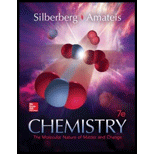
Interpretation:
The given ionic reaction has to be balanced and the
Concept Introduction:
An
Galvanic cell consists of two half-cells. The redox reaction occurs in these half-cells. The half-cell in which the reduction reaction occurs is known as the reduction half-cell, whereas the half-cell in which the oxidation reaction occurs is known as the oxidation half-cell.
The standard cell potential for voltaic cell is determined by subtracting the electrode potential of cathode and the electrode potential of cathode.
The negative cell potential of a redox reaction indicates that the reaction is not spontaneous which shows that the standard free energy should be less than 0. The reverse reaction of this will be definitely a spontaneous reaction with cell potential value greater than 0.
- Chemical equation is the representation of a
chemical reaction , in which the reactants and products of the reactions are represented left and right side of an arrow respectively by using their respective chemical formulas. - Reactant of a chemical reaction is the substrate compounds or the compounds which undergo a chemical reaction.
- Product of a chemical reaction is the produced compounds or the compounds formed after a chemical reaction.
- Balanced chemical equation of a reaction is written according to law of conservation of mass.
- Stoichiometry of a chemical reaction is the relation between reactants and products of the reaction and it is represented by the coefficients used for the reactants and products involved in the chemical equation.
Want to see the full answer?
Check out a sample textbook solution
Chapter 21 Solutions
Chemistry: The Molecular Nature of Matter and Change - Standalone book
 ChemistryChemistryISBN:9781305957404Author:Steven S. Zumdahl, Susan A. Zumdahl, Donald J. DeCostePublisher:Cengage Learning
ChemistryChemistryISBN:9781305957404Author:Steven S. Zumdahl, Susan A. Zumdahl, Donald J. DeCostePublisher:Cengage Learning ChemistryChemistryISBN:9781259911156Author:Raymond Chang Dr., Jason Overby ProfessorPublisher:McGraw-Hill Education
ChemistryChemistryISBN:9781259911156Author:Raymond Chang Dr., Jason Overby ProfessorPublisher:McGraw-Hill Education Principles of Instrumental AnalysisChemistryISBN:9781305577213Author:Douglas A. Skoog, F. James Holler, Stanley R. CrouchPublisher:Cengage Learning
Principles of Instrumental AnalysisChemistryISBN:9781305577213Author:Douglas A. Skoog, F. James Holler, Stanley R. CrouchPublisher:Cengage Learning Organic ChemistryChemistryISBN:9780078021558Author:Janice Gorzynski Smith Dr.Publisher:McGraw-Hill Education
Organic ChemistryChemistryISBN:9780078021558Author:Janice Gorzynski Smith Dr.Publisher:McGraw-Hill Education Chemistry: Principles and ReactionsChemistryISBN:9781305079373Author:William L. Masterton, Cecile N. HurleyPublisher:Cengage Learning
Chemistry: Principles and ReactionsChemistryISBN:9781305079373Author:William L. Masterton, Cecile N. HurleyPublisher:Cengage Learning Elementary Principles of Chemical Processes, Bind...ChemistryISBN:9781118431221Author:Richard M. Felder, Ronald W. Rousseau, Lisa G. BullardPublisher:WILEY
Elementary Principles of Chemical Processes, Bind...ChemistryISBN:9781118431221Author:Richard M. Felder, Ronald W. Rousseau, Lisa G. BullardPublisher:WILEY





